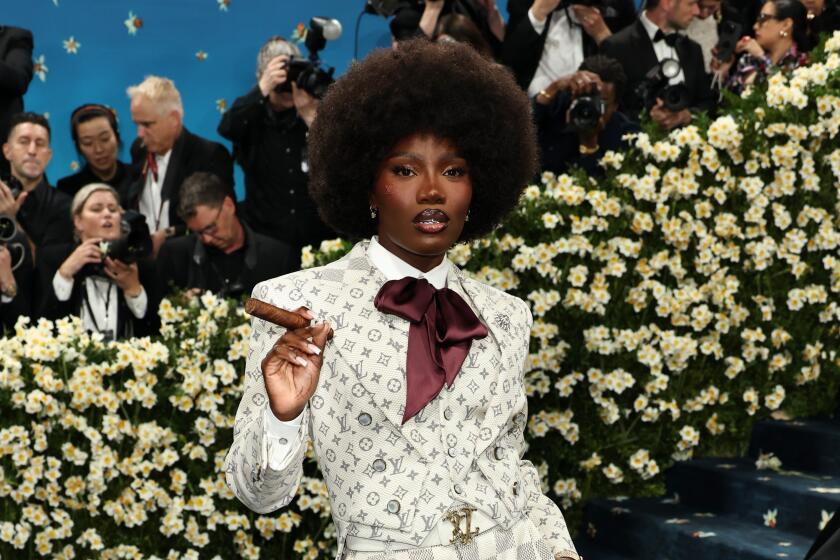In This Field, There Really Is a Fine Art to Investing
- Share via
NEW YORK — A long, graceful curve rises skyward, dips suddenly and then resumes its ascent. The line isn’t art but does tell you a lot about its value over the last century.
This arc, on a graph, traces the direction of the prices for artworks at New York auctions, just as the Dow Jones industrial average tracks the stock market. Its designers hope their new index will make the fine-art market easier to understand--and invest in.
“The world of art is about beauty and imagination, while the world of economics is about reason and number-crunching,” says Jianping Mei, a finance professor at New York University’s Stern School of Business, who created the index with Michael A. Moses.
“Our job was to bring the two together, to find rationality in the world of emotion and to discover order in the wild art market of Van Gogh and Picasso.”
The Mei/Moses Fine Art Index, which starts in 1875, charts the dramatic rise in prices from World War II until 1990, when a recession doused the surging market for European and American masterpieces. Starting from a baseline value of 100, the market peaked in 1990 at 2,476, before dropping 20% during the next four years. By last year, art prices had fully recovered, reaching a level of 2,566, although the Impressionist works still lag their top performance, according to the index.
“Art is a wonderful long-term store of value, like real estate, whose value has increased greatly over the last century,” says Moses, who also teaches at Stern. “As an investment, art gives a return comparable to government bonds, plus you have something nice to hang on your wall.”
Moses, a collector of postwar American art and an expert in 18th century Newport furniture, jokes that he initially invested in art so he wouldn’t have to ride the emotional roller coaster of the stock market. Later, however, he decided that he could systematically measure changes in the overall market with a comprehensive database of the prices that paintings fetched at public auctions.
Thirteen years ago, Moses began tracking Impressionist, American and Old Master paintings that had been sold since 1950 at New York’s largest auction houses: Christie’s and Sotheby’s. Trawling through dusty catalogs at the New York Public Library and the Metropolitan Museum of Art, Moses’ team was able to trace the purchase prices of 4,500, some as far back as 1675.
Last fall, he hooked up with Mei, an international finance expert who had a passion for researching “underdeveloped markets.”
The markets may not seem similar at first, but the bidders at art auctions have a lot in common with buyers of suburban condos and Malaysian stocks. Like real estate or financial markets in developing nations, art auctions have relatively few buyers and sellers, low trading volume and little information about the price history of comparable objects.
“The problem is that you can’t divide art,” explains Moses. “You can’t buy 1 inch of a Picasso like you can own one share of IBM.”
The Mei/Moses index suggests that the overall art market provides lower returns on investment than corporate bonds or stocks in the Dow and the Standard & Poor’s 500 index.
In addition, short-term investors in art are like day traders in the stock market. “You can make a killing or get killed,” Mei says.
Christie’s spokeswoman Andree Corroon says that the idea of an index is interesting but points out that any comprehensive database would need to include results from dealers, galleries and private sales.
The Mei/Moses index challenges the most basic advice art dealers give to their clients: Buy the most expensive pieces, since they hold their value best.
Instead, the professors find that the higher the purchase price, the lower the return on investment when it is sold. In other words, the buyers of art on the low end and middle of the price scale often earn a higher rate of return than buyers who get fixed on a famous image.
For example, at the market’s peak, Marc Chagall’s painting of a violinist playing in a world turned upside down was purchased at a 1989 auction for $4.2 million. “Le Violoniste au Monde Renverse” sold this month for $2.1 million.
Once the spring auction results are added, the index could be used to help determine how the current economic downturn is affecting the art market. The index already shows major price drops during the Depression and the 1974 oil crisis.
More to Read
The biggest entertainment stories
Get our big stories about Hollywood, film, television, music, arts, culture and more right in your inbox as soon as they publish.
You may occasionally receive promotional content from the Los Angeles Times.







